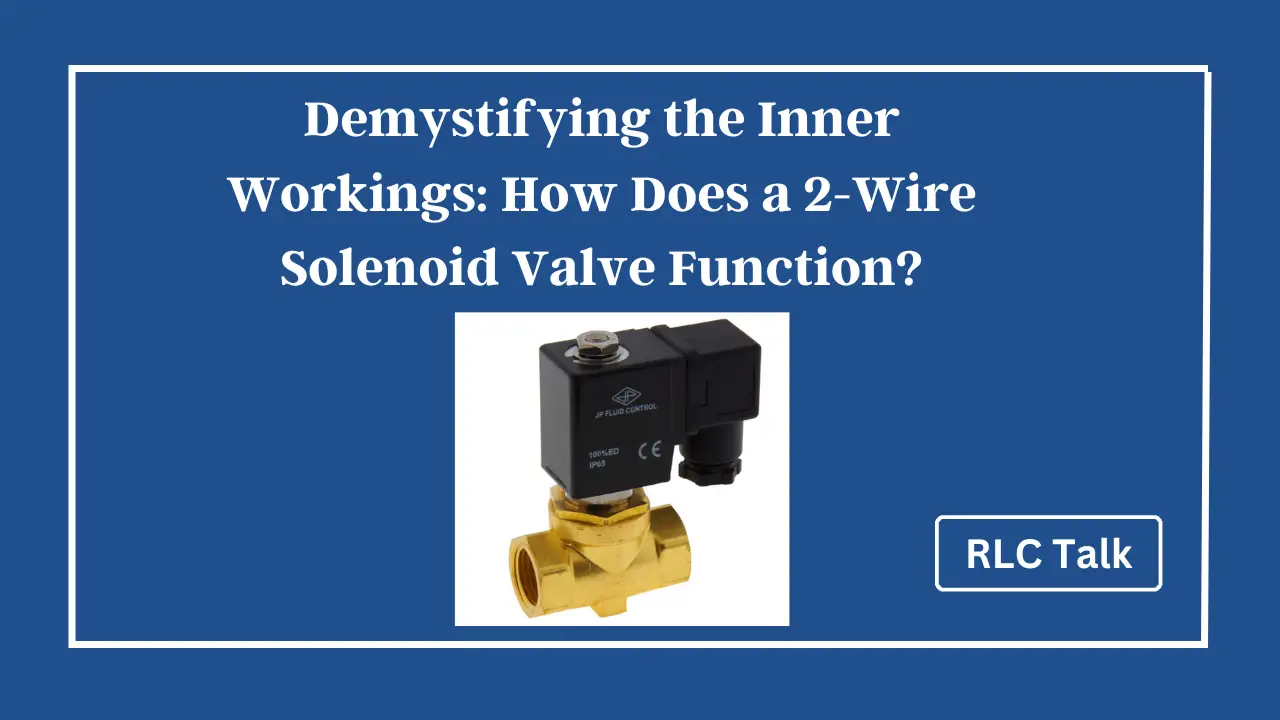Demystifying the Inner Workings: How Does a 2-Wire Solenoid Valve Function?
Attention DIY enthusiasts and curious minds! Are you ready to unlock the secret behind powering up your projects with precision and control? Look no further, because today we’re diving headfirst into the electrifying world of solenoid valves.
Imagine having the power to manipulate the flow of liquids or gasses at your fingertips, effortlessly turning your ideas into reality. In this guide, we’ll demystify the process and reveal the hidden wiring wizardry required to master the art of harnessing a 2-wire solenoid valve.
Get ready to bring your projects to life with a jolt of innovation and electrifying results!
Solenoid valves are essential components in various industrial and commercial applications, controlling the flow of liquids or gasses with precision and reliability. Understanding how solenoid valves work is crucial for anyone involved in fluid control systems.
Basics of solenoid valve operation

Before discussing the intricacies of 2-wire solenoid valves, let’s first understand the fundamental principles of solenoid valve operation. A solenoid valve consists of two main components: a solenoid coil and a valve body.
The solenoid coil is an electromagnet that generates a magnetic field when an electric current passes through it. This magnetic field attracts or repels a plunger or a movable core within the valve body, which controls the flow of fluid through the valve.
When the solenoid coil is energized by an electrical current, it creates a magnetic field that pulls the plunger or core towards it, allowing the fluid to flow through the valve.
Conversely, when the current is interrupted, the magnetic field dissipates, and a spring or other mechanical mechanism pushes the plunger or core back into its original position, shutting off the flow of fluid. This simple yet effective mechanism forms the basis of solenoid valve operation.
Understanding the 2-wire solenoid valve
Now that we have a general understanding of how solenoid valves operate, let’s focus on the 2-wire solenoid valve. As the name suggests, a 2-wire solenoid valve is wired using only two wires, making it relatively simpler to install and connect compared to other types of solenoid valves.
The 2-wire solenoid valve consists of a solenoid coil and a valve body, just like any other solenoid valve. However, it differs in its wiring configuration. In a 2-wire solenoid valve, both the power supply and the control signal are carried through the same two wires.
This simplifies the wiring process and reduces the number of connections required, making it a popular choice for many applications.
Step-by-step guide: How to wire a 2-wire solenoid valve
For a more detailed step-by-step guide on wiring a 2-wire solenoid valve, please refer to the following:
- Begin by gathering the necessary tools and materials, including a 2-wire solenoid valve, wires, wire connectors, a power supply, and a control signal source.
- Identify the positive and negative terminals of the power supply and the control signal source.
- Connect the positive wire from the power supply to one terminal of the solenoid coil using a wire connector.
- Connect the negative wire from the power supply to the remaining terminal of the solenoid coil using a wire connector.
- Connect the control signal wire to the same terminal of the solenoid coil to which the positive wire from the power supply is connected using a wire connector.
- Connect the remaining wire from the control signal source to the remaining terminal of the solenoid coil using a wire connector.
- Inspect the connections to ensure they are secure and free from any loose wires or connectors.
- Once satisfied with the wiring, apply power to the solenoid valve and test its operation.
Following this step-by-step guide will ensure a successful wiring of a 2-wire solenoid valve.
How to Wire a 2-Wire Solenoid Valve: A Comprehensive Guide
rlctalk.com
Testing a 2-wire solenoid valve
After wiring a 2-wire solenoid valve, it is essential to test its functionality to ensure proper operation. To test a 2-wire solenoid valve, perform the following steps:
- Apply power to the solenoid valve by connecting the power supply.
- Activate the control signal source (e.g., toggle the switch or send a signal from a PLC) to energize the solenoid coil.
- Observe the movement of the plunger or core within the valve body. It should move in response to the energized solenoid coil, allowing fluid to flow through the valve.
- Deactivate the control signal source to de-energize the solenoid coil. The plunger or core should return to its original position, shutting off the flow of fluid.
- Repeat this testing process multiple times to ensure consistent and reliable operation.
By following these testing procedures, you can verify the proper functioning of a 2-wire solenoid valve.
Wiring a solenoid valve to a switch
To wire a solenoid valve to a switch, follow these steps:
- Identify the terminals of the switch. The switch typically has two terminals.
- Connect one wire from the power supply to one terminal of the switch.
- Connect the remaining wire from the power supply to one terminal of the solenoid coil.
- Connect the remaining terminal of the switch to the remaining terminal of the solenoid coil.
By following these steps, you can wire a solenoid valve to a switch, allowing manual control of the valve’s operation.
Common issues with wiring solenoid valves
While wiring solenoid valves is generally straightforward, certain issues may arise. Here are some common problems and their solutions:
- Incorrect wiring: Ensure that the wires are connected to the correct terminals of the solenoid valve and the power supply or control signal source.
- Loose connections: Check all wire connections to ensure they are secure and free from any loose wires or connectors.
- Short circuits: Inspect the wiring for any exposed wires or damaged insulation that may cause short circuits. Replace any damaged wires or connectors.
- Insufficient power supply: Confirm that the power supply can provide enough voltage and current to energize the solenoid coil.
By addressing these common issues, you can avoid wiring problems and ensure the proper functioning of solenoid valves.
Exploring double solenoid valves
In addition to the 2-wire solenoid valve, there is another type known as the double solenoid valve. A double solenoid valve has two solenoid coils and is designed to control the flow of fluid in two directions. The operation of a double solenoid valve is more complex than a 2-wire solenoid valve but offers greater control and flexibility in fluid control systems.
A double solenoid valve is typically wired using four wires, with two wires for each solenoid coil. The wiring configuration will depend on the specific application and control requirements. If you are working with a double solenoid valve, refer to the manufacturer’s documentation for the appropriate wiring instructions.
Conclusion
Understanding the inner workings of solenoid valves is crucial for anyone involved in fluid control systems. We have explored the basics of solenoid valve operation and focused specifically on 2-wire solenoid valves.
Mastering the inner workings of solenoid valves empowers you to effectively control the flow of fluids in various applications, from industrial machinery to commercial systems. With this knowledge, you can ensure the optimal performance and reliability of solenoid valves in your projects.
FAQ
Are solenoids AC or DC?
How many wires are connected to a solenoid?
What is a 2-position solenoid valve?
When activated, usually by applying power to the solenoid, the valve switches to its second position, opening the flow path and allowing the fluid or gas to pass through. The valve remains in this second position until the power is removed or deactivated.


